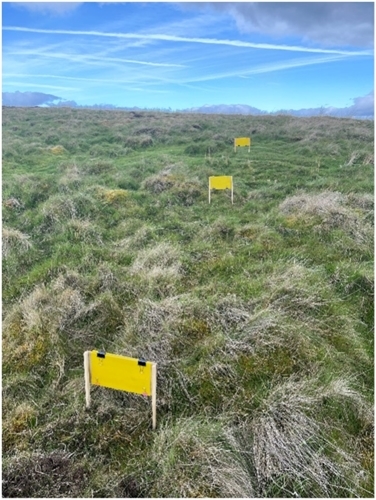By Leah Cloonan and Lucy Marsden, Uplands Team
A new fieldwork season has begun and along with it a new project, bringing new tasks. The maternal red grouse condition project commenced in March when 70 red grouse hens were caught from seven different study sites in Upper Teesdale, North Pennines. Measures of body size (wing length and weight) and condition (breast muscle index) were taken from each hen.
Caecal samples, containing strongyle worm eggs from which to estimate parasite intensity, were obtained by individually boxing them up overnight, before releasing them back to their catch point the next morning but now equipped with a radio tracker. Since then, we have tracked the locations of each hen weekly.
 A member of the uplands team radio-tracking red grouse.
A member of the uplands team radio-tracking red grouse.
Whilst tracking the tagged birds, we established heather and cotton grass sampling plots within each study site. These species comprise a large part of an adult grouse’s spring diet. For five consecutive weeks during March and April, we sampled heather and repeat counted cottongrass flower heads. The samples will soon be sent off for nutritional analysis, as the quality of this vegetation could play a vital role in a hen’s condition leading up to and during the breeding season.
During the last month, we have hit a pivotal moment within the project. We have been visiting the sites in the hope of finding many a grouse nest, and so far, we have found 63 nests, and measured 545 eggs, which averages 8.7 eggs per nest! We have also used some, new to us, technology in the form of an ‘i-Button’.
This is a wireless data logger, which we placed in the nest to measure temperature every seven minutes; with this we were hoping to capture the frequency and length of incubation breaks and establish either hatch dates or timings of failure for each clutch. In the event of a failure, these data can also give us a clue as to which predator was involved in the event.
 Measuring clutches of grouse eggs in the field.
Measuring clutches of grouse eggs in the field.
Being hesitant about this new form of technology, we are pleased to report some impressive results (see Figure 1). The graph clearly shows regular incubation breaks where the nest temperature drops by around 2 degrees before rising again when the hen returns to recommence incubation. The steep sudden decline on the 05/05/2022 at 18:53 represents the nest being predated, which we can pinpoint to within a seven-minute timeframe.
The subsequent fluctuations in the temperature represent the daily rise and fall of the outside temperature between 06/05/2022 and 08/05/2022. From these data we have determined that incubation breaks last 20-30 minutes and occur regularly around four or five times per day, being broadly synchronous across all study sites. We now have collected back 40 i-Buttons from either failed or hatched nests, with more to be collected from nests that are still yet to hatch. We are looking forward to seeing how these data develop further.

Figure 1: Graph showing temperature changes of a grouse nest which has been predated.
For the past three weeks, clutches have been hatching. Once a clutch hatches, we put out three yellow sticky flyboards in typical foraging areas used by chicks to measure cranefly abundance, a vital part of a chick’s diet. Our current tally is 44 hatched nests, and as you can probably imagine, we now have a lot of insects to count!
 Flyboards placed in a typical brood foraging area.
Flyboards placed in a typical brood foraging area.
So far, this year is looking to be a positive one for red grouse, with an abundance of cottongrass flower heads, a timely greening of heather, and emergence of craneflies broadly synchronous with the hatching of chicks.
The next steps for this project in the coming weeks are going to be estimating chick survival rates by flushing broods with a pointing dog and counting chicks; measuring vegetation height, composition and density at nests; and calculating grouse territory sizes from successive tracking locations. By doing so, we hope to understand more about how the maternal condition of grouse pre-breeding affects their ability to produce a successful brood.
Sign up to the GWCT Uplands Newsletter
Get updates on our latest uplands research by signing up to our newsleter here.